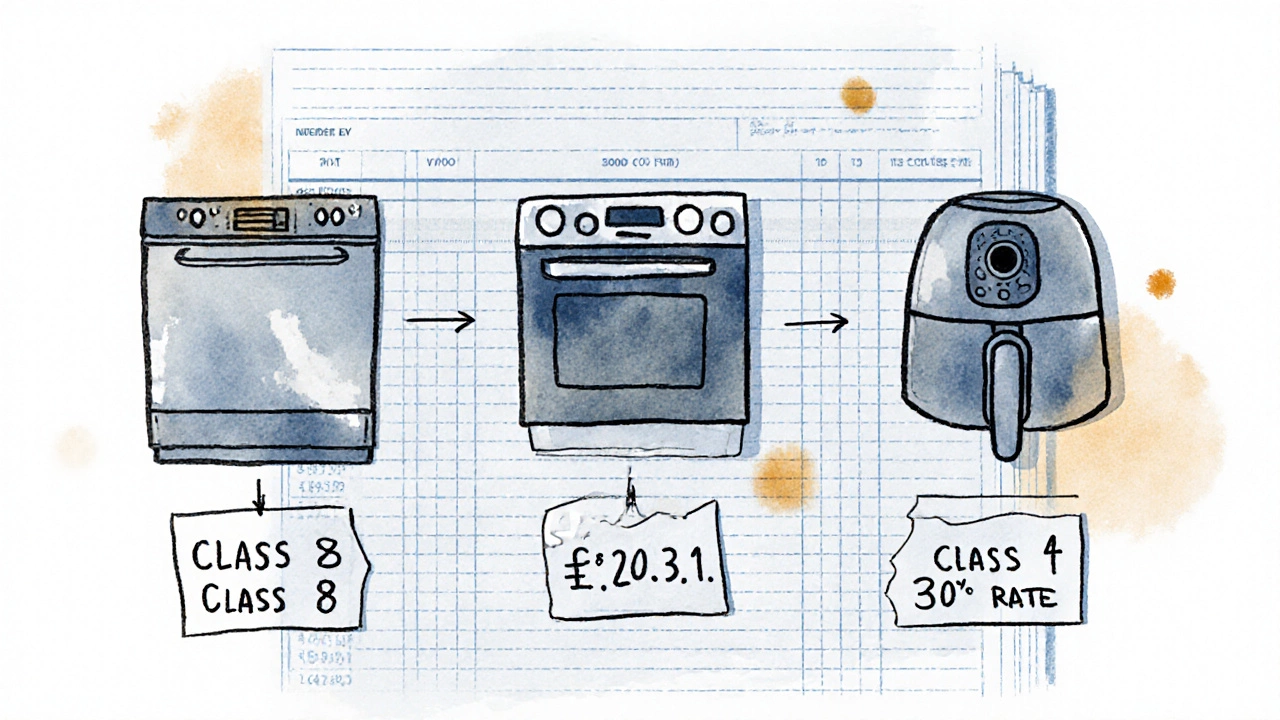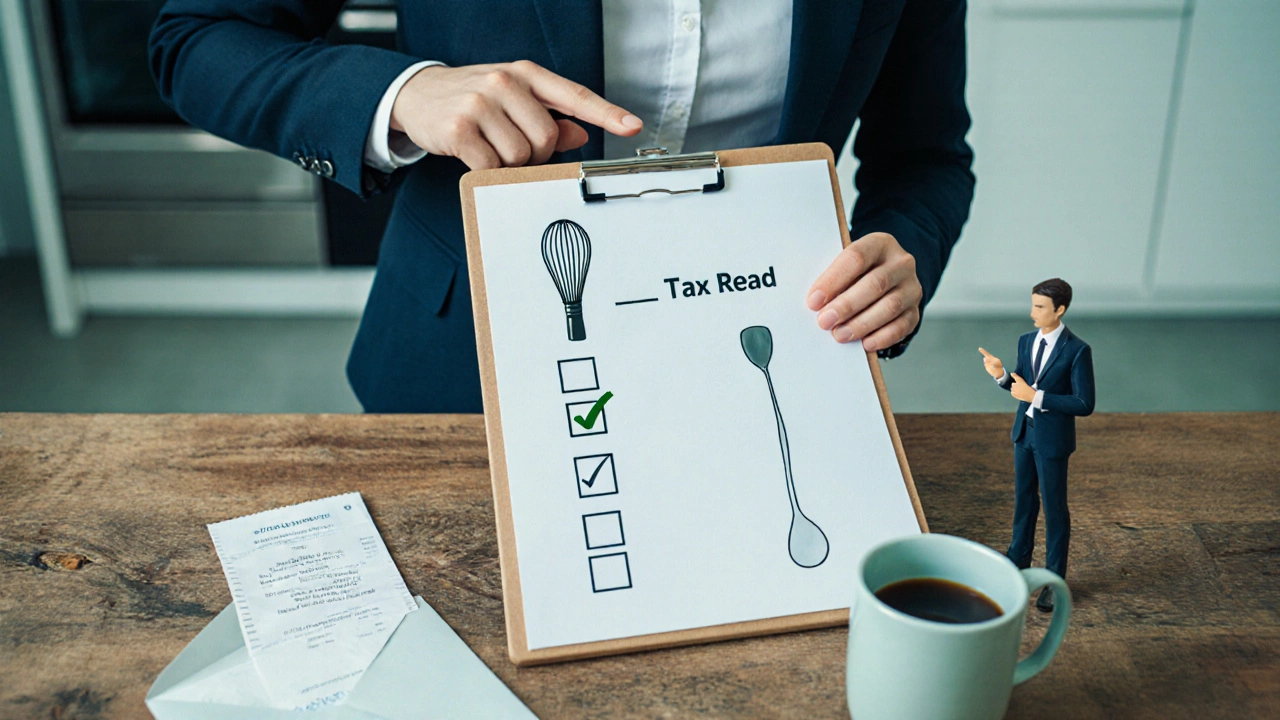Kitchen Appliance Tax Write-Off Calculator
Calculate Your Appliance Deduction
Calculate your annual Capital Cost Allowance deduction for business-use kitchen appliances. Enter the purchase price, business-use percentage, and select the CCA class to see your potential tax savings.
Quick Summary
- Only appliances used for business, rental, or home‑office purposes can be written off.
- Most kitchen gadgets are considered capital assets, so you claim depreciation (CCA) rather than a full expense.
- If you use an appliance partly for personal cooking, you must split the deduction by the business‑use percentage.
- Keep receipts, invoices, and a clear log of how often the appliance is used for work.
- Canadian tax rules differ from U.S. rules - the CRA governs what you can claim.
Understanding the Basics
When you wonder tax write off appliances, the first thing to know is that the Canada Revenue Agency (CRA) treats most household items as capital property, not regular expenses. That means you can’t just write off the full price of a new blender or coffee maker in the year you buy it. Instead, you claim a portion of the cost each year through the Capital Cost Allowance (CCA) system.
Appliance is a device that performs a specific household function, such as cooking, cleaning, or food preservation. For tax purposes, the CRA groups appliances into classes (e.g., Class 8 for most kitchen equipment, Class 43.1 for certain energy‑efficient devices). Each class has a prescribed depreciation rate.
The CRA also defines a Tax Deduction as an amount that reduces your taxable income. In the case of appliances, the deduction comes from the CCA claim or, in rare cases, from an immediate expense if the item qualifies under a special provision.
When Can You Claim an Appliance?
Three main scenarios let you write off a kitchen appliance:
- Home‑office business: If you run a freelance food‑blog, catering service, or small bakery from your kitchen, the appliances you use for that work can be partially deductible.
- Rental property: Landlords who provide a fully‑furnished unit with a working kitchen can claim the appliances as part of the rental‑property expenses.
- Self‑employed culinary business: Chefs, personal chefs, or cooking‑class instructors may treat their kitchen gear as business assets.
If you simply bought a new air‑fryer for personal use, the CRA will not let you claim it.
How Much Can You Deduct? The Capital Cost Allowance (CCA) Explained
The CCA works like depreciation on a car. You assign the appliance to a class, then apply the class’s rate to the remaining undepreciated balance each year. The most common class for kitchen gear is Class 8, which carries a 20 % declining‑balance rate.
Example: You buy a $1,200 commercial‑grade stand mixer for your catering side‑hustle.
- Year 1 CCA = 20 % × $1,200 = $240
- Undepreciated balance after Year 1 = $960
- Year 2 CCA = 20 % × $960 = $192
- ...and so on until the balance reaches $0.
If you only use the mixer 60 % of the time for business, you claim 60 % of the CCA amount each year (e.g., $144 in Year 1).
Some modern, energy‑efficient appliances fall under Class 43.1, which allows a 30 % rate, giving a quicker write‑off.

Current Expense vs. Capital Asset: When Each Applies
Most kitchen appliances are capital assets, but a few low‑cost items can be treated as current expenses. The CRA’s $500 threshold is a useful rule of thumb: if the purchase price is $500 or less, you may elect to expense it fully in the year of acquisition.
| Criteria | Current Expense | Capital Asset (CCA) |
|---|---|---|
| Typical cost | ≤ $500 | > $500 |
| Claim method | Full amount in the year bought | Depreciation over several years |
| Record‑keeping | Simple receipt | Detailed log + depreciation schedule |
| Examples | Hand blender, small kettle | Dishwasher, built‑in oven, commercial‑grade mixer |
Even if an item is under $500, you can still choose the CCA route if you think the asset will be used for many years and you want to spread the deduction.
GST/HST Input Tax Credit (ITC) for Business‑Use Appliances
If you’re registered for GST/HST, you may claim an Input Tax Credit on the tax portion of the purchase price, again proportional to the business‑use percentage. For a $1,200 appliance with 13 % GST, the tax paid is $156. If you use the appliance 50 % for your home‑based bakery, you can claim $78 as an ITC.
Remember: you must have a valid GST/HST registration number and maintain a clear audit trail.
Step‑by‑Step: Claiming Your Appliance on Your Tax Return
- Determine the business‑use percentage. Keep a usage log for at least one year (e.g., “Monday‑Friday lunch service, 4 hours/day”).
- Assign the appliance to the proper CRA class (usually Class 8 or Class 43.1). Use the CRA’s “CCA Class Table” as reference.
- Calculate the CCA amount for the year, then apply your business‑use %.
- If you’re filing a home‑office or self‑employment return, enter the CCA on Schedule T2125 - Statement of Business Activities. The form asks for “CCA - Class 8” and lets you specify the percentage.
- For rental‑property owners, list the CCA on the “Rental Income” section of the T776 form.
- Claim any applicable GST/HST ITC on the GST/HST return (Form GST34).
- Keep the original receipt, the usage log, and a copy of the depreciation schedule for at least six years.
Pro tip: If you’re just starting a home‑based business, you can claim the “small‑business deduction” on the first $500 of CCA in the inaugural year, giving a nice quick boost.

Common Pitfalls and How to Avoid Them
- Mixing personal and business use: Never claim 100 % on an appliance you also use for family meals. The CRA audits this frequently.
- Failing to keep a log: A simple spreadsheet showing dates, hours, and purpose is enough. Without it, the CRA will default to a 50 % business-use rule, which may be too low.
- Choosing the wrong CCA class: Using Class 1 (4 % rate) on a kitchen mixer will stretch the deduction over decades. Double‑check the CRA’s class guide.
- Missing the $500 expense election: If you bought a $450 specialty espresso machine, you could have deducted the full amount instantly. Review the expense‑vs‑CCA decision each year.
- Not registering for GST/HST when required: Once your gross revenue exceeds $30,000 in a 12‑month period, registration is mandatory, and you lose the chance to claim ITCs on past purchases.
Checklist: Write‑Off Ready Appliances
- Is the appliance used >50 % for business, rental, or home‑office work?
- Do you have a dated receipt and, if possible, the vendor’s GST/HST number?
- Is the purchase price ≤ $500 (eligible for full expense) or > $500 (requires CCA)?
- Have you logged the usage for at least 12 months?
- Did you assign the correct CRA class and depreciation rate?
- If you’re GST/HST registered, have you calculated the proportionate ITC?
Cross‑checking each item before you file can save you from a nasty audit later.
Mini‑FAQ
Can I write off a dishwasher in a rental‑unit kitchen?
Yes. If you provide a fully‑equipped kitchen for tenants, the dishwasher is a capital asset. Claim it on the T776 form using the appropriate CCA class (usually Class 8) and apply the business‑use % (typically 100 % for a fully furnished rental).
What if I only use a coffee maker for my home‑office 30 % of the time?
Record the 30 % usage, then claim 30 % of the CCA (or the full expense if the price is under $500). Include the amount on Schedule T2125 under “CCA - Class 8.”
Do I need a separate GST/HST number for my kitchen‑appliance business?
No separate number is required. Your existing GST/HST registration covers all taxable supplies, including kitchen‑appliance services. Just claim the ITC on the portion of tax paid for business‑used appliances.
Can I claim a blender I bought for my smoothie‑prep vlog?
If the vlog generates business income and the blender is used solely for that purpose, it qualifies. Treat it as a capital asset (Class 8) unless the price is ≤ $500, in which case you can expense it fully.
What records should I keep for a claimed appliance?
Save the original receipt, any warranty documents, a log of business‑use hours, and the depreciation schedule you filed. Keep everything for at least six years after the tax year.
Next Steps If You’re Unsure
Tax law can be tricky, especially when personal and business lines blur in a kitchen. Here’s what to do next:
- Run a quick audit of all appliances you own. Note the purchase price, date, and primary use.
- Use the checklist above to separate deductible items from personal ones.
- If the numbers look confusing, book a short consultation with a tax professional familiar with small‑business and rental‑property deductions.
- Update your bookkeeping software to include a “Appliance CCA” asset class - many free tools let you set custom depreciation rates.
Taking a few minutes now can turn a $2,000 kitchen upgrade into a solid tax reduction for years to come.

